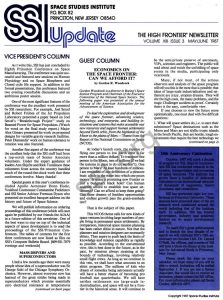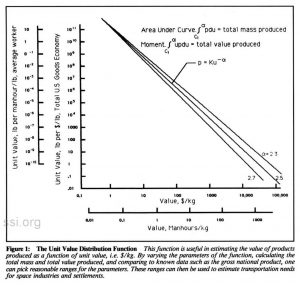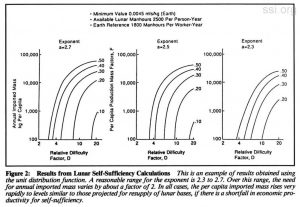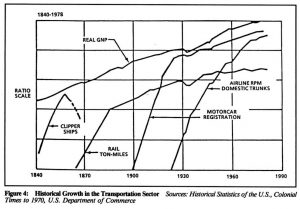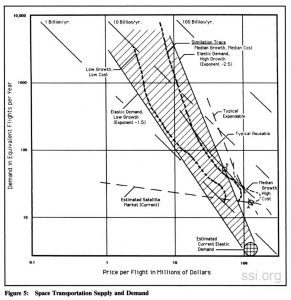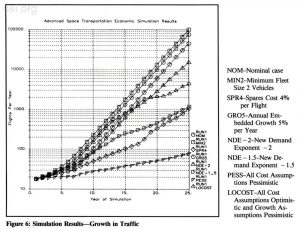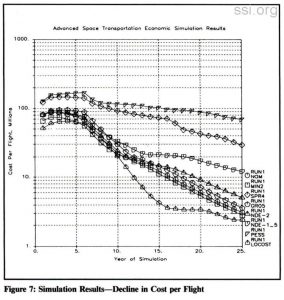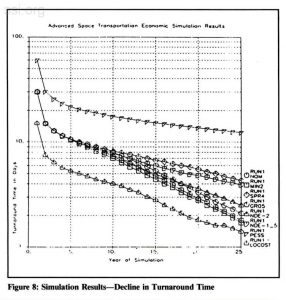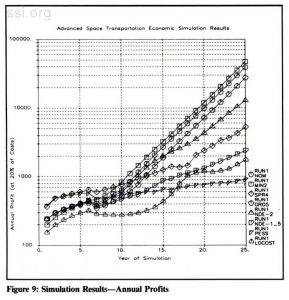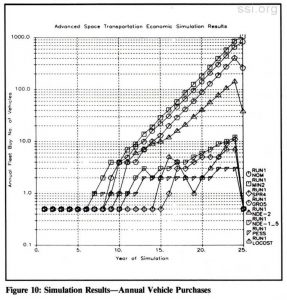SPACE STUDIES INSTITUTE
P.O. BOX 82
PRINCETON, NEW JERSEY 08540
[[librarian note: This address is here, as it was in the original printed newsletter, for historical reasons. It is no longer the physical address of SSI. For contributions, please see this page]]
SSI UPDATE
THE HIGH FRONTIER® NEWSLETTER
VOLUME XIII ISSUE 3
MAY /JUNE 1987
VICE PRESIDENT’S COLUMN
As I write this, SSI has just concluded its Eighth Princeton Conference on Space Manufacturing. The conference was quite successful and featured new sessions on Human Physiology and on Space Biospheres and Closed cycle life support. In addition to the formal presentations, this conference featured two evening roundtable discussions and an ambitious poster session.
One of the most significant features of the conference was the excellent work presented by SSI researchers. For example, Joel Sercel and Robert Frisbee of the Jet Propulsion Laboratory presented a paper based on Joel Sercel’s “Breakthrough Project” study on Beamed Power for Space Propulsion. (Watch for word on the final study report.) Major Alex Gimarc presented his work on proposed designs for variable gravity research facilities. Peter Diamandis’ work on human tolerance to rotation was also featured.
Another fine aspect of the conference was the excellent help that the SSI staff had from a top-notch team of Senior Associate volunteers. Under the expert guidance of leaders Ann Shjefte and Rick Tumlinson these volunteers from across the country handled much of the round-the-clock work that these conferences involve. Many thanks!
Special guests at this year’s conference included Apollo Astronaut Donn Eisele, Voskhod Cosmonaut Constantine Feoktistov and SSI Senior Advisor Freeman Dyson who presented an excellent banquet address on the history and future of Space Science.
We will publish information on ordering proceedings of this conference (which will once again be published by our friends the AIAA) in a future edition of this newsletter. One of the best ways to stay on top of the technical aspects of space development is to read the proceedings of the SSI/Princeton Conferences. The tables of contents for the first three conferences are now listed as files on SSI’s Computer Bulletin Board. xxx-xxx-xxxx evenings and weekends.
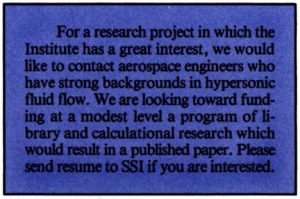
MASS-DRIVERS AND SUPERCONDUCTORS
Until a few months ago there were many people whose idea of a superconductor was Sir George Solti of the Chicago Symphony Orchestra. However, almost everyone now has learned of the great strides being made in superconductors which promise essentially zero electrical resistance at temperatures perhaps as high as liquid nitrogen. A common question is what effect this work has on SSI’s Mass-Driver Research. One of SSI’s remaining key areas of work in this area has to do with how to power the bucket of the MassDriver without sliding contacts. Because of their short lengths, we have been able to use tethers in our test models.
We are looking in two general directions. The first of these is to transmit energy to the moving bucket using the “barrel” of the MassDriver as a waveguide. The second approach is to use some of the energy induced in the bucket coil by the drive coils as the bucket traverses the machine. Interestingly, SSI had originally planned to use a superconducting bucket. Mass-Driver II was designed with this in mind and a team at MIT built a cryogenic cooling station which was exhibited at the 1979 Princeton Conference. The improved accelerations made possible by Mass-Driver III technology (O’Neill’s pull-only long wave design) actually worked better than what could be achieved using “old-style” superconductors.
The new work, which is being reported almost daily, promises superconducting materials which not only can work at relatively high temperatures but which also can produce the strong magnetic fields that we need. Despite some newspaper accounts however, it will take some time before the hardware store clerk says “Regular or superconducting?” when you ask to buy some wire. Given the rapid progress in this field SSI has elected to observe developments rather than to spend resources to freeze (pardon the pun) the design of mass-drivers using what may be obsolete technology in a few months. We are following developments in this area closely and will keep you advised.
Gregg Maryniak
GUEST COLUMN
ECONOMICS ON THE SPACE FRONTIER: CAN WE AFFORD IT?
by Gordon R. Woodcock
Gordon Woodcock is a director in Boeing’s Space Station Program and Chairman ofthe Executive Committee of the National Space Society. The following paper was presented at the annual meeting of the American Association for the Advancement of Science.
To lead the exploration and development of the space frontier, advancing science, technology, and enterprise, and building institutions and systems that make accessible vast new resources and support human settlements beyond Earth orbit, from the highlands of the Moon to the plains of Mars. – Theme from the Report of the National Commission on Space (NCOS).
At today’s launch costs, the expense of flying one person to low Earth orbit is far more than a million dollars. To transport one person to the Moon, tens of millions (if we had the systems in place to do so; we don’t). One person to Mars? At least hundreds of millions. I am reminded of one definition of a pleasure boat: a hole in the water into which one pours money. Is space a promising new frontier or just a budgetary black hole? Can human societies afford to establish true space settlements? Can we afford to keep them going? Can these dreams of limitless opportunities and endless growth pass the green-eyeshade test?
That is the subject of this paper.
This NCOS theme calls for new kinds of space ventures involving large numbers of people living in permanent space settlements. By comparison, historical space mission planning has been rather elitist in nature. Not that the planners and mission designers are necessarily elitists. They aspire to push back the limits of knowledge and mission capability as rapidly as possible. According to the conventional view, this is best done in the future, as in the past, by missions always straining at the bounds of technology, involving relatively small flight crews. As long as we continue in this vein, we shall have what amounts to an elitist program. The millions of kids who dream of someday being astronauts actually will have a better chance of becoming pro football star quarterbacks. We will have neither settlements nor large-scale industrialization, and space will not be a frontier in the historical sense. It will continue to be the semi-private preserve of astronauts, VIPs, scientists and engineers. The public will read about and watch the unfolding of space events in the media, participating only vicariously.
Many, if not most, of the serious observers and analysts of the space program will tell you this is the most that is possible; that ideas of large-scale industrialization and settlement are crazy, utopian dreams. They will cite the high costs, the many problems, and the tragic Challenger accident as proof. Certainly theirs is the easy, comfortable view.
If one chooses to view the future more optimistically, one must deal with five difficult questions:
1. What will space settlers do, i.e. to earn their subsistence? Space destinations such as the Moon and Mars are not idyllic tropic islands in the South Pacific, they are hostile, tough environments that require the best technology we can muster just to survive. (Through application of advanced technology on a massive scale, space habitats might become idyllic, as envisioned by O’Neill.) If the settlers are more than very few, we cannot presume that they will forever be wards of the U.S. taxpayers. The public who pay the taxes expect their investments in space to one day have tangible payoffs they can benefit from, and not just through non-stick skillets.
2. Viable settlements must maintain the technological means of survival primarily through their own resources and then have output left over for export trade. Can space settlements be self-sufficient and productive enough to survive economically as well as technically? Is there some sort of plausible import/export balance?
3. Can the U.S. as a nation, or jointly with other nations, afford this? Can we project any scheme for economic feasibility? In particular, is there any hope that prospective space settlers could someday afford to buy their own tickets to emigrate?
4. Is there an evolutionary path? At today’s costs we can’t afford large-scale operations and without large-scale operations, we can’t obtain low costs. Suppose we could imagine a future large-scale transportation fleet carrying passengers and freight at, say, a few thousand dollars per ticket: Is there a plausible evolution from today’s modest launch rates and high costs to this large-scale fleet?
5. When, how, and where? If we wish to act on the NCOS theme, how do we formulate plans and policy?
Question 1. Productive activities for space settlers
The first space settlement’s proposal to have an air of reality about it was offered by O’Neill in 1974[1] Accordingly, it was the first to be challenged as to what productive work space settlers would do to economically justify their existence. Since the O’Neill proposal happened along during studies of large-scale solar power generation in space solar power satellites (SPSs) – construction of these huge artifacts from lunar-derived materials by space settlers was quickly proposed as a logical answer to the question[2] Studies and debates went on for several years[3.4]. This particular answer became moot, at least for the present, when active studies of SPSs were discontinued in 1981.
The O’Neill settlements were by nature large, a minimum size being on the order of 1000 people[5]. Consequently, only large-scale activities such as SPS construction seemed suited to them. More recently, other ideas have appeared, notably the supply of liquid oxygen produced on the Moon to low Earth orbit[6,7], and supply of lunar or asteroidal materials for radiation shielding and “armoring” military installations in space. These activities are suited to smaller installations, especially on the Moon.
The economic payoff from production of oxygen and other materials in space is in elimination of transportation cost for delivering them from Earth. This must be compared to the cost of installing and supporting a facility to deliver these materials to space destinations from the surface of the Moon. The tradeoff can be represented by a “breakeven” equation that compares capital and recurring costs of the lunar operation to the recurring costs of supply from Earth. Intuitively, it would seem that such a scheme cannot possibly be economic, but a break-even analysis indicates that it can[8], provided that the market for lunar oxygen in low Earth orbit, for example, is as large as 1000 tons per year. This figure is typical of the rate of oxygen consumption that would attend a modest manned Mars exploration program. Economic advantage is possible because it is difficult and expensive to deliver products from the surface of the Earth to space, but (in principle) much easier to do so from the surface of the Moon. Such a lunar surface facility would employ roughly 20 people, a number more appropriate to a base than a settlement, but even at that size, local food production is justified.
A key factor in the break-even analysis is the cost of lunar surface equipment compared to the cost of space transportation. The results described assumed the cost of the equipment as produced on Earth to be equal to the cost of transporting it to low Earth orbit, as is typical for space hardware today. If, in the future, transportation costs were to drop dramatically without a corresponding drop in space hardware costs, economic advantage for lunar production might disappear. However, the economic advantage increases dramatically for uses of products in the lunar vicinity or in geosynchronous orbit, and is greatest for uses of material on the lunar surface where produced.
Scientific and technical information is clearly the easiest extraterrestrial product to produce; it is routinely delivered by unmanned spacecraft and is presently the only product of human operations in space. There are numerous proposals for scientific research and research facilities on the Moon[9], and the potential scientific returns from manned explorations of Mars are evident. Products of high specific value such as specialty electronics might be produced on the Moon or anywhere and be exported to Earth at a profit. There are no known unique materials or conditions on the Moon or Mars that would lead to exports of special value, but people coping with the challenge of existence in a space settlement and needing exports are likely to innovate salable unique processes or products that would find a niche in the marketplace, just as people anywhere else do.
Finally, real estate or emigration rights could be a marketable commodity for space settlers. If a settlement needed certain imports from Earth to survive and grow, but was otherwise self-sufficient with productive capacity to construct accommodations and infrastructure capable of supporting immigrants, the sale of passenger, and personal freight tickets and settlement occupation rights could supply the income needed for the imports. Such a scenario implies transportation costs low enough for the emigres to afford the fare, as does any true settlement scenario where the option to emigrate to space is an individual decision and the emigration is individually financed. Difficult questions of ownership and title would have to be solved. Existing treaties prohibit ownership of extraterrestrial real estate by nations of Earth but do not speak to the question of ownership by settlers. Probably this entire question was thought irrelevant when the treaties were written. Ownership might not be required; “occupation rights” might be sold.
Question 2. Can Space Settlements Be SelfSufficient and Productive?
A completely self-sufficient space settlement needs no export to maintain itself. A nearly self-sufficient settlement needs only modest export to balance its modest import. A settlement or base with no steps towards self-sufficiency needs massive import, or as better known, resupply. Taking extremes, a base on the Moon operating with space station technology would need at least 2000 kg resupply per person per year. At projected transport costs for an early lunar base activity, the cost for crew exchange and resupply is on the order of a million dollars per man-day, or $100,000 per hour[10] (The Apollo missions were two orders of magnitude more expensive than this.) Larger bases and initial steps towards self-sufficiency such as local food growth can reduce this by about two orders of magnitude but the resulting $1000 per hour is still formidable insofar as productivity and export products are concerned. At the other extreme, a completely self-sufficient settlement would need no support from Earth and would have no continuing cost. (There is, of course, the question of start-up cost.) Any scientific data received would be “free,” and the level of trade would be whatever makes economic sense.
The Apollo missions to the Moon were entirely open-loop. Oxygen, water, food, and electrical power came from onboard stores. Spare parts and capital facilities were not neededon these short trips. The space station will recycle water and oxygen and employ a degree of onboard repair using spare parts supplied from Earth. Self-sufficiency implies local production and recycling of air, water, food, spare parts, capital facilities, and supplies necessary for makeup of the inevitable wearout, leakage and losses from the space facility. Most of the enormous diversity of products we use here on Earth is required.
Production offood and certain industrial raw materials has been studied in depth and exploratory experiments have been carried out with respectable success. Manufacture of a few finished products such as structural members and solar cells has been studied in less depth. The overall problem of making everything from machine parts to toothpaste is largely unexplored. Key issues include human productivity, the size of labor force necessary to obtain a sufficient skill mix, and the magnitude and nature of capital facilities.
A parametric approach has been used to interrelate the issues of productivity and quantity of imports required[11] This approach makes use of a unit distribution function as depicted in Figure 1. The integral of the function yields the total annual mass of products produced by an economy and the first moment integral yields their total value. Analysis of these integrals permits estimating the form of representative distribution functions and selection of parameter values. Estimates for known economies aid extrapolation to possible extraterrestrial ones. Reference 11 cited above describes selection of suitable functions and estimation of a range of parameter values for a lunar settlement. It was found helpful to introduce a relative difficulty factor D, and a production mass factor f. The former is the ratio of lunar to Earth manhours needed to produce similar products, and the latter is the ratio of annual per capita production. For example, we might find that it takes five times as many manhours to produce a particular type of product (say, steel tubing) on the Moon as on Earth, due to diseconomies of small scale and other factors. If this were average for all products, then D = 5. However, because the lunar settlement is small and enjoys, in some respects, a simpler life style, the annual per capita total mass of products (of all types) might only be 30% of that for the U.S. economy on Earth; then f = 0.3.
Since space transportation is expensive, we employ a strategy of devoting local production to the products having the least labor intensity in manhours per kg, and importing those with greatest intensity, and therefore least shipping mass for the labor thereby saved.
The result is a parametric estimate of the amount of resupply, i.e. import, required from Earth, shown in Figure 2. The significance of the result is that essentially complete selfsufficiency is needed to avoid high space transport costs.
It is important to recognize that this parametric productivity comparison deals with the U.S. economy as a whole and not with aerospace industry products. For a variety of reasons, aerospace productivity is far less than the U.S. industrial average. This means that space settlements will somehow have to attain levels of productivity higher than the present aerospace industry average in order to reach self-sufficiency. It may not be as difficult as it first seems, since many of the products will be relatively unsophisticated. Further, engineering of the products will ordinarily not have to be done locally.
Complete self-sufficiency on the Moon may not be possible because of scarcity of certain elements. Carbon, nitrogen, and hydrogen, for example, are scarce, as are some metals in industrial use. We might be fortunate enough to find better concentrations of the metals, but supplies of the volatiles are unlikely. Even in a nominally closed system some volatiles will be lost, e.g. due to air leakage. Makeup rates on the order of 100 kg annually per capita are likely to be required.
Mars has an atmosphere; although nitrogen was measured by Viking to be present at only 2.57 concentration, this is enough to make a breathable atmosphere by straightforward processing. Carbon is plentiful as carbon dioxide. Water vapor is scarce and liquid nonexistent, but ice may be available. Iron and aluminum were found by Viking; little is known about other metals. Complete selfsufficiency on Mars may be achievable; there are today no known reasons to exclude it.
Viewed from an economics perspective, however, Mars has the disadvantage of being far less accessible than the Moon. A trip to the Moon from Earth is possible more or less any time and only takes three to five days. A round trip requires one to three weeks. A departure to Mars is possible only during a roughly one month launch window every 26 months. A round trip requires 1.5 to three years. Consequently, scientific information may be the most practical product supplied from a Mars settlement to Earth.
One study[12] examined the possibility of supplying volatiles to the Moon from the moons of Mars, concluding that the idea held promise. Although the trip times from the moons of Mars are long and the low-energy launch windows infrequent, the propulsive energy required is quite low. The moons of Mars are believed to be similar to carbonaceous chondrite meteoritic material. If so, they contain significant fractions of water and other volatiles scarce on the Moon.
I answer Question 2, in summary, as follows: (a) Space settlements on the Moon or in free space can be 99% self-sufficient as measured by the percentage of annual per capita production that must be imported from Earth; space settlments on Mars might be 1OO% self-sufficient; and (b) relatively high human productivity in space is required in order to achieve self-sufficiency. We are not presently able to estimate the prospects for achieving the necessary levels of human productivity except to say that it is only a question of time. Advanced techniques in automation and robotics are presumably needed.
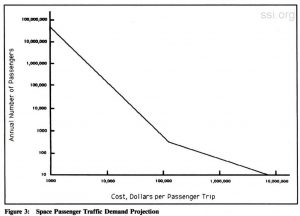
Question 3. Are space settlements affordable?
The O’Neill-style settlements (space colonies) proposed and widely discussed a few years ago had a typical mass on the order of a million tons. They were to be man-made artifacts in space, hence a form of spacecraft. Present-day costs for spacecraft are on the order of ten millions per ton. One could (people did) estimate the cost of a space settlement as the product of these large numbers, ten trillion dollars, and quickly write off the whole idea as totally unfeasible financially.
A small permanent habitable base on the Moon, capable of accommodating, say, six to twelve people, would be about 100 tons mass. Although hardly a settlement in the sense of permanent self-sufficiency, such an installation could and probably would include at least some local food growth provisions, an initial step in the right direction. Estimating as above, the cost is one billion dollars. This base would be like a space station on the Moon; one is justified in guessing its cost to be about that of the planned NASA space station: several billions. Either way, it is clearly in the affordable range.
A small initial presence on the Moon could be made to grow with time and to incrementally develop the technologies of selfsufficiency. A small presence can grow to a larger one much less expensively than might be imagined; one study of lunar logistics and operations showed that plausible advances in self-sufficiency technologies (food growth and local production of oxygen and structural materials), and in space transportation, could make the cost of supporting a thousand people on the Moon to be no more than the early cost of supporting a dozen[13]. The cost feasibility of human presence on the Moon in numbers more than a few dozen was shown, in the same study, to hinge on the feasibility of producing most of the settlement physical plant from local (lunar) materials and local resources.
If one argues that after an initial startup period, space settlements will be built by the settlers, cost estimates obtained by multiplying settlement mass and spacecraft costs are meaningless. The “cost” of the settlers’ labor is a “cost” accepted and borne by the settlers themselves. This was all pointed out by O’Neill and others several years ago, in papers arguing that we could dispatch “self-replicating machines,” i.e. intelligent robots, to the Moon where they would build the space settlement infrastructure[14]. I believe, however, that the most practical “self-replicating machines,” available in the foreseeable future, and capable of developing techniques for space settlement self-sufficiency, are human beings.
To make a long story short, the physical facilities of space settlements are affordable if and only if built by the settlers themselves from local materials. The technology for doing so is the same as needed for self-sufficiency in the first place. If space settlements are feasible by way of being adequately self-sufficient, they are affordable. At least, a settlement of some size is feasible on a financial scale of national space programs.
The question remains whether emigres could afford the ticket price. If not, the scale of space settlements will be limited in some way by how much the taxpayers of one or more nations are willing to underwrite by providing space transportation service. A settlement could grow at a slow rate by human reproduction, but the level of passenger traffic and import-export would be limited by the capability of a publicly-funded space transportation service. Alternatively, if emigres and tourists could afford tickets, the traffic would be limited only by market factors. For verification I point to the fact that the annual operating expense for U.S. commercial passenger jet travel is more than ten times what NASA spends on the space shuttle.
Few people could afford to ride the shuttle. If its payload bay were equipped with an airline-like interior, complete with life support systems, it could carry about 75 people to orbit per trip. Ignoring the cost of this interior, using present estimates of shuttle flight costs on the order of $120 million, the cost per passenger is about $1.6 million. That figure includes neither a profit for the operator nor amortization of the capital investment in the shuttle fleet.
At the other extreme, millions pay a thousand or so for airline travel. Society Expeditions, a company that specializes in exotic tours, found numerous takers for prospective trips to orbit at fifty thousand; people signed up with a substantial deposit for a promised trip years in the future (the offering has, to the best of my knowledge, been shelved for the present time). Society Expeditions published, at the 1985 L5 Conference, an estimate of the number of tourist-trip-to-orbit tickets they could sell annually as a function of price. It is reproduced in Figure 3. They projected nearly a million passengers annually at a ticket price of $10,000. If one could find a way to fly a space shuttle two orders of magnitude more cheaply and still make a profit, one might make a lot of money. A million passengers annually at 75 per trip is more than 10,000 flights per year, compared to the anticipated shuttle rate of ten to fifteen. Before the possibility is dismissed as ridiculous, take note that the fuel for a shuttle flight to orbit costs considerably less than $10,000 per (hypothetical) passenger.
A number of investigations have examined the prospects for low cost space transportation; I published last year a specific investigation of lower bounds on launch costs[13]. Most such investigations project costs far lower than today’s. If one adopts a commercial outlook (it will presently become clear why I choose to), one should consider five categories of cost: (1) Recovery of research and development, (2) Amortization of fleet investment, (3) spares (repair parts), (4) operations labor, and (5) propellant and other fixed costs. At high launch rates, or with some sort of government sharing, research and development can be finessed. The other costs are unavoidable. It is instructive to consider what is needed to bring each of these others down to one million dollars per flight.
Amortization – The production unit cost of a reusable launch vehicle will be on the order of a billion dollars, whether rocket or airbreather. Typical commercial practice is to amortize the investment in a vehicle over a five year period. With straight-line depreciation, the annual write-off is $200 million and the vehicle must fly to orbit 200 times per year to attain the target. To last for five years at that rate, the vehicle must have a life of at least 1000 flights. By comparison, a shuttle orbiter can fly four to six times per year and has an estimated life of 100 flights. Over a sustained high-launch-rate program, production cost reductions due to learning and production rate could reducee the unit cost by a factor of several; use rates on the order of fifty to one hundred per year would then reach the million dollar amortization goal.
Spares – The use clearly must be about 0.1% per flight or less. Shuttle figures have not been published, but are probably somewhere between 1% and 10%.
Operations labor costs – If one includes all such costs, this item must include mission control operations and the astronaut corps as well as turnaround labor. The cost per flight is affected by the size of the total labor force and the total number of flights. One can express this as the total labor force per vehicle and the number of flights per vehicle per year. If we consider that one vehicle must fly fifty or more times per year to achieve its amortization target, and that average labor costs are on the order of $40,000 per manyear, then the labor force per vehicle is fifty flights times $1 million divided by $40,000, i.e. 1250 people. This is smaller than shuttle by a factor of no more than a few, and is not nearly as great a challenge as the targets just discussed. The reason, of course, is that the fast turnaround demanded to attain the amortization targets accomplishes most of the needed reduction in labor cost per flight.
Propellant and fixed costs – Propellants, if low-cost liquid propellants are used exclusively, will be less than half a million per flight. Other fixed costs will be low at high launch rates.
The cost targets described here are great challenges. As man is (geometrically) halfway between atoms and stars, these targets are halfway between shuttle and commercial jetliners. Turnaround in a few days may seem incomprehensible in light of shuttle operations, but flying machines of comparable complexity are routinely turned around in an hour or less at commercial airports.
Launch costs of a million dollars per flight do not defy laws of physics or even economics, but they place severe performance and life demands on launch vehicles and clearly can only be reached at launch rates far higher than any published traffic forecasts. What is the outlook for high traffic rates? Most of the present uses of space involve expensive spacecraft by agencies with more or less fixed budgets for space activities. The demand for launch services is primarily for launching spacecraft, and is limited not only by the cost of launch services but also by the cost of the spacecraft themselves. The cost of a launch is typically about half for launch service and half for spacecraft. Consequently the increase in demand that might attend lower cost launch service is limited; even if launches were free the demand would probably not double.
Even the beginnings of settlement activities would increase demand. Reference 13 estimated a need for ten to fifteen shuttle equivalent launches per year to support a six-person lunar base, up to about 200 per year to support a thousand people on the Moon in a quasi-settlement (tours of duty of several years and local food growth). Various studies of manned Mars landing missions have estimated on the order of 100 equivalent shuttle flights to assemble and fuel the planetary vehicle in Earth orbit; these launches would have to occur in about a year (or less). Looking further out, if a million people lived on the Moon, the minimum import-export trade would probably require 2,000 or more equivalent shuttle flights. If passenger traffic were 1% of the population, about that many more flights would be demanded.
There are less speculative potentials. The Society Expeditions projection forecasts millions of space tourists at prices below $10,000 per ticket. Commercial materials processing in space could, in the future, generate substantial demand. Today’s conventional wisdom is that it will not. Today’s conventional wisdom is derived from transportation costs exceeding $2,000 per pound combined with a lack of research and production facilities in orbit. Elementary analysis shows that this situation leads to very small demand. Even with adequate facilities in orbit, the demand at current costs is projected as no more than a few equivalent shuttle flights per year.
These kinds of demand – tourism, space materials processing, and settlement traffic – have characteristics that should exhibit high elasticity. These are: lack of fixed budget limits, potentially large markets, and unlike the satellite market, space transportation itself is the principal cost driver. “High elasticity” of demand means that as prices drop, sales volume increases so rapidly that total revenue increases. If sales volume is represented as proportional to price raised to an exponent, the exponent is less than -1. (At -1, revenue is constant with decreasing price.) Exponent values appear to range from -1.5 to -2.5 in typical situations. The cost of sales (production and other) must decrease fast enough with increasing volume to maintain a profit margin. The existence of rapid growth industries, where technology improvements and cost reduction drive rapidly expanding markets, is adequate proof that highly elastic demands exist. No one cuts prices to lose money! Whether space transportation markets will behave in this fashion is presently speculative, but most other segments of the transportation sector have done so in the past, as illustrated in Figure 4.
If one postulates a two-segment demand model for space transportation with one segment a satellite-type market and the other a highly elastic demand market, one gets a picture like Figure 5. Both demand models are shown, with the satellite-type market having a demand of about fifteen equivalent shuttle flights per year, but the highly elastic market having a demand level of only three equivalent shuttle flights per year at present prices. Also shown in the figure are typical launch service costs for newly developed expendable and reusable launch systems, including a reasonable rate of amortization of research and development cost. Where the launch service cost curve is above the demand curve, the demand does not support a price high enough to cover the costs. Where the cost curve is below, the demand supports a price high enough to be profitable. Point “A” on the figure is a stable point where cost and demand are in balance. An attempt to provide more service is unsuccessful in generating enough more demand to support a profitable price. Providing less service opens a profitable market for another supplier. Point “B” is unstable. More service generates rapidly increasing profits, and the opportunity for profit leads to rapid market growth.
The cost characteristics illustrated are for a reusable system designed for low cost at high rates as described earlier. The cost characteristic crosses into a region of rapid growth, assuming the estimate of demand elasticity for the “new” market segment is correct, at about fifty flights per year. Only fully reusable systems are predicted to decrease in cost rapidly enough with launch rate to enter the growth region. Partially reusable systems like space shuttle, not shown, are predicted to track quite close to the expendable curve. There is a “Catch-22” here: the only systems capable of low costs that would stimulate rapid growth of commercial space transportation are more expensive than other alternatives at present demand levels. Further, even the existence of high demand at low costs is speculative.
I will argue in answering the next question that there are plausible paths to low launch cost, if in fact the elastic demands exist. This addresses only the issue of affordable tickets to orbit. What about settlement destinations? Reference 13, quoted earlier, analyzed a wide range of lunar logistics scenarios and found that under technology scenarios likely to exist after settlements are established, i.e. when propellant oxygen is available from the Moon, the cost of a person-round-trip to the Moon is about ten times that of a trip to orbit. Most of the additional cost is for propellant that must be delivered to orbit (even with oxygen refueling on the Moon) to operate the lunar transportation system. Amortization of the lunar transportation system itself is about one-third of the total transportation cost. If a trip to orbit could be bought for $10,000, a trip to the Moon would be roughly $100,000. Not exactly a casual tourist excursion but many people, wanting to emigrate badly enough to spend a large part of their net worth, could afford to do so.
Mars is considerably more difficult, mainly because of the long trip times at low energy. The least expensive plausible lowenergy scenario hypothesizes an interplanetary ship similar in size and shape to the upper stage of an Earth-to-orbit vehicle. We presume refueling is available on Mars. The velocity increment (delta V) to depart Earth orbit, arrive at Mars by aerocapture, and land on the surface, is about 6 km/sec, nearly identical to that for a launch vehicle upper stage. The delta V to launch from Mars’ surface to a trans-Earth trajectory and arrive at Earth by aerocapture is about 7 km/sec. These delta V’s assume use of the low-energy transfer opportunities that occur about every 26 months. The round trip time is somewhat less than three years. One vehicle could make repeated round trips, departing Earth every 52 months. It could, I assume, carry about forty people. This is somewhat generous, given the trip time of several months. If accommodations as spacious as those considered proper for space station are demanded, the passenger capacity will be more like twenty. Even at forty, however, the long trip time creates a cost problem. The unit cost of this vehicle will be on the order of half a billion dollars (at least!). With five-year amortization, the write-off per passenger is ten million; with ten-year amortization it is still five million. This time-cost-of-money problem, incidentally, also militates strongly against the “cycling spaceships” (bases circulating in repeating orbits between Earth and Mars) described in the NCOS report.
The solution is high-energy propulsion and shorter trip times. The trip time to Mars is roughly inversely proportional to rocket jet velocity. The energy of the rocket is proportional to jet velocity squared. A cost optimization is possible, trading amortization cost with energy cost. A representative result yields a specific impulse of 10,000 seconds (jet velocity 100 km/sec), a round trip time of about two months, and a cost per passenger on the order of one million dollars. This performance is in the range believed attainable by fusion propulsion, assuming it becomes feasible in the future. The cost still exceeds the Moon by an order of magnitude, but a small settlement devoted mainly to scientific exploration would be possible. Society Expeditions projected between ten and a hundred passengers annually, for a sightseeing trip to Earth orbit, at a million dollars per passenger. The opportunity to travel to another planet at that price would, I presume, be more attractive.
In summary, I answer Question 3 as follows: Settlements on the Moon are affordable, even to the point of emigres financing their passage, provided there is enough demand for Earth launch operations to support launch traffic of a few flights per day. Passenger trips to the Moon are indicated as about ten times more costly than to low Earth orbit. Passenger trips to Mars are indicated as ten times more expensive than to the Moon; at least fifty times more with known technology. Settlements on Mars could be feasible if financed by a government (even at ten millions per trip an annual budget of a billion dollars covers 100 trips per year). Personally financed emigration to Mars is dubious. but conceivable. From the space transport standpoint, O’Neill-style settlements in cislunar space are less costly than the Moon but there remains the question of affording initial development of these enormous fabricated structures. Given the relative inaccessibility of Mars, i.e. the infrequent launch windows and long trip times, and the resulting high cost and risk, the Moon is the obvious choice for beginning a settlements activity.
Question 4: Is There an Evolutionary Path?
This question directly addresses the “Catch-22” of how to make a transition to affordable operations on a settlement scale when present costs are far too high to permit the flight rates that lead to low cost. To analyze this question, I set up a simple dynamical economic model of demand versus price, and launch costs versus launch rates. The model assumes that a reusable system capable of low costs at high rates becomes available without direct commercial investment in the research and development of the vehicle. Table 1 summarizes the input parameters to the model.
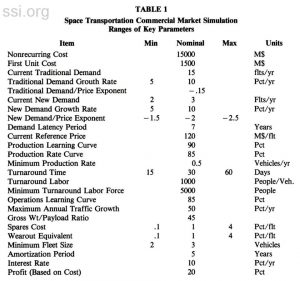
Nonrecurring cost (i.e. research and development, not including any flight units) was estimated as 15 billions. This figure is clearly very uncertain as it depends on the type and degree of advancement of the technology. Either rocket or “Orient Express” airbreather technologies will likely be on this order. Since research and development amortization was not included in the simulation, its cost is mainly of interest from a public policy point of view.
First unit cost is for the first production unit. Subsequent units are typically less expensive as calculated by “learning” and “rate” formulas. The formulas express the decrease in cost attendant to a doubling of the number of units (or the production rate) and are given in percent. I used 90% learning and 85% rate. This means that the second unit cost is 90% of the first unit cost; the 20th 90% of the tenth. The rate base was one unit per year. At two units per year, the cost for a given unit would be 85% of the one-unit rate; at 1/2 unit per year, 118%. The mathematical expression for the cost factor is N raised to the power log<sup>0.01p</sup>/log<sup>2</sub>. At 90% learning, the exponent is -0.152. The table also states an operations learning curve; the same type of expression was used to estimate the turnaround time on the Nth flight from the stated value of turnaround time, which is for the first operational flight.
Demand projections used annual growth rates combined with price factors. The annual growth rate was assumed to apply to fixed launch price. In addition, demand was assumed elastic with price as discussed above. Variations in demand with price were assumed to involve a latency period, with demand increasing along a seven-year S curve following a price change. This presumes that users of space transportation will begin to respond to price changes only after the changes go into effect. Seven years was selected as a maximum commercial user payload development period.
The demand model included two components as discussed above, a “traditional” component comprised mainly of spacecraft, and a “new” component of Spacelab and space station service missions, servicing of industrial activities in low Earth orbit, advanced lunar and planetary manned missions, tourism, and settlement activities. The current reference price is approximately that charged for shuttle launches. Current expendables comparable to the shuttle are more expensive (except the Soviet Proton, rumored to be available at about $40 million per launch).
A minimum production rate was assigned, as it is impractical to shut down a production line and restart it later. Since the minimum fleet was capable, in most cases, of more flights than initially demanded, the simulation would have shut down production without this provision.
Turnaround time was reduced according to the operations learning curve, but the turnaround labor force per vehicle was held constant at 1000. The minimum turnaround labor force was set at 5000. Although this may seem excessive, turnaround labor was less than 10% of the cost per flight in all cases.
Some of the simulations would have increased traffic at extreme rates without the 50% per year cap. Even this is a high growth rate, but industrial experience indicates it is commonly achieved where justified by demand growth.
Spares and wearout costs were varied over a 40:1 range, appropriate to the great uncertaintity in those parameters for future systems. An amortization period of five years was used as typical of the accelerated depreciation presumably applicable to space transportation vehicles. The interest rate is appropriate to a non-inflationary analysis such as this one, and was applied to the total non-depreciated fleet investment as a cost in addition to depreciation. Fleet acquisition buys were determined from the number required to achieve launch rate, wearout, minimum fleet size, or minimum production rate, whichever governed. Total cost per flight was the sum of depreciation and interest costs for the fleet, spares costs, labor costs, and propellant costs, all divided by the number of flights for the year. Profit was added to the total to give price per flight. The change in price from the prior year was used to adjust demand for the outyears according to the demand formulas and the seven-year S curve. Cases were run to explore the effect of the variations in parameters indicated in the table.
The most significant results are shown in figures 6 through 10 on the following pages. All cases except one followed a consistent pattern: For the first five or so years, transportation price per flight is dominated by the cost of amortization of the initial fleet, the minimumallowed 1/2 vehicle per year production, and its amortization. The price is not a great deal less than the reference of $120 million. High demand generation due to price reduction does not occur. After the initial fleet is amortized, the price drops enough to begin stimulating rapid demand growth. Demand growth and economies of scale feed on one another to cause a dramatic increase in the market and decrease in price per flight. The only case for which this did not occur was when the launch cost drivers of spares cost, wearout, and turnaround time were all set at their most pessimistic values. The result was that prices dropped little and demand grew slowly.
The rate of demand growth was, as expected, sensitive to the value of the “new demand” exponent. Even for the least negative value of -1.5, however, demand growth exceeded 1000 flights per year after 25 years. The value of this exponent, and even the existence of a highly elastic “new demand,” are uncertain. All that can be said is (a) the economic ingredients for elastic demand are present, and (b) when they are present, history shows that elasticity exponents are much more negative than -1, the “unitary elasticity” value. At that value, lowering prices does not increase revenue and rapid-growth markets driven by declining prices simply would not exist. But they do, and not only are they common, I cannot think of a major industry that did not go through a rapid growth phase driven by this phenomenon.
One should ask why this has not happened in space. First of all, it has! The annual tonnage in orbit increased by about 50% per year from 1958 through 1969, accompanied by a reduction in cost from about a million dollars a pound to a thousand. The U.S. put about a million pounds (equivalent; most of the launch capability went into the Apollo lunar missions) in orbit in 1969. That amount has not been equalled since, but would have in 1987 or 1988 had it not been for the Challenger accident. Since 1969, the cost has been “stuck” at roughly a constant value.
The technology of launch systems reached a plateau with the Saturn and Titans of circa 1970. While the shuttle incorporates dramatic new technology, it does not do so in a system configuration conducive to low cost; indeed, the shuttle is about even with its older technology competitors in delivery cost to orbit. Design of the shuttle was driven by strict constraints on total research and development cost combined with the desire to have a returnable manned orbital system that could carry out missions such as Spacelab. Reducing launch cost was a secondary objective; despite high hopes, it was in fact reduced little.
Rapid growth in space traffic has been stalled out since 1970 because the costs are “stuck.” As illustrated in Figure 5, cost versus traffic trends for expendable launchers cannot stimulate demand growth. Shuttle-type craft with expendable or solid rocket boosters follow essentially the same trends with the same results. Reusable systems designed for low recurring cost per flight could stimulate rapid market growth if my estimates of demand models are correct and if the nonrecurring research and development cost could be absorbed in some fashion not requiring recovery through launch price in the early years.
Due to inflation, what was $1000/lb in 1969 is now about $3000/lb. Several studies, including this one, have shown that there isn’t much, at present flight rates, that can be done to dramatically reduce cost. Consequently, many studies conclude that we can’t and shouldn’t do much. The usual formulas recommend “expendables,” and often commercialization of the space launch market, without being very specific. Commercialization is a tough nut to crack. The truly commercial market for satellite launch is small and fragmented among several international competitors. What I have characterized as “new demand” in this paper must have a round-trip shuttle craft of some sort; these users cannot fly on expendables.
Some U.S. companies are trying to make a go of it with existing launchers, but none except start-up companies (which, according to some analysts, understand neither the risks nor the costs) are offering new systems. The government is a large enough user to stabiliize the market if it would guarantee to purchase private launch services from competent offerors, but so far it has not. Expectations that private companies will risk the many billions needed to bring in a viable nextgeneration reusable system, given the present market size, are irrational. There is not even any assurance today that the government would permit its operation, and the present insurance situation is all but hopeless even for those who merely want to cover the launch of a communications satellite.
[[librarian note from 2015: This is an amazing article but please read that last part again and look at the reality we actually have now from certain private players. Just to put a bit of perspective on what is often considered very professionally as ‘irrational’. Once one door is opened, are the other impossible blockages also truly closed?]]
In summary, I answer Question four as follows: There are economically plausible evolutionary paths by which space transportation operations could “bootstrap” from today’s low traffic and high cost to the reverse situation. These paths require that a second-generation reusable launcher somehow be brought into being without amortization of its nonrecurring development becoming an albatross around the neck of a prospective commercial operator. If that can somehow occur, and if the other substantial barriers to commercialization of space transportation can somehow be surmounted, economic bootstrapping of demand growth and cost reduction can bring about an era of affordable large-scale industrialization and settlement.
Question 5: When, How, and Where?
This paper has recounted some wellknown ideas on space industrialization and settlement and introduced a few new ones. To answer the question, we need to briefly explore the policy issues raised by these ideas.
Space settlers will need an economic export base just as any other colony or settlement. Under any space transportation scenario for which settlements are economically feasible, there are plausible settlement-produced products that could provide the base. Space settlements will need to be nearly self-sufficient; this creates important research and engineering implications such as development of practical production systems for raw materials and finished products. Space settlers will have to be highly productive in order to produce nearly all their material needs from indigenous resources. There has not been enough study and experimentation on this to be more specific; I presume that advanced automation and robotics will be needed.
Although partly new, these points are not surprising and do not pose particularly difficult policy issues. Research funds should be applied to development of practical processes for fabrication and manufacturing from extraterrestrial materials, and to application of advanced robotics to special needs of space manufacturing. Quite modest funding should enable rapid progress for several years since this would begin as small-scale research.
The results described in this paper indicate that fully reusable launch vehicles, capable of operating at low costs at high launch rates, do not offer cost advantages at present launch rates of twenty-odd or less per year. This is hardly new; similar results are found in twenty-year-old literature. Low costs are attainable at high launch rates; this is not new. Projections of very low (by usual standards) launch costs at very high rates are also not new. Although often disbelieved, such results are easily obtained, and represent a real possibility. While it is usually assumed that design details of reusables do not matter very much if the launch market is large enough to justify reusables, results obtained here and in some of the references indicate that these details, especially turnaround time, spares, and vehicle life, matter greatly. A poor job of obtaining low-cost design characteristics in these areas could lead to a real “white elephant” system, expensive to develop and expensive to operate. A “shuttle-II,” or whatever we choose to call it, should be designed for low cost operation from the outset, and this is so important that it should carry the weight of national policy. Every design choice must be driven by operational performance (like turnaround time) and cost and not by proving the latest technology tricks.
The possible existence of a segment of the space launch market with highly elastic demand is a new idea. The satellite launch market is unlikely to ever generate enough demand to make space launch a major industry like air travel and air freight. New kinds of demand, highly elastic with price, could do so, if prices are brought down by a reusable system that operates at low cost at high rates. Profound policy implications exist if this is true. Technological leadership in the development of advanced reusable launch systems then has great significance to economic growth and balance of trade. If the elastic demand models are valid, the U.S. should make every effort to maintain leadership in this field. If these models are not valid, reusable launch technology is not economically important. I believe the models are valid; that histodcal analogs provide all the demonstration that is needed. (Not to mention that they are all the demonstration available.)
A space station is needed in low Earth orbit to encourage the evolution of elastic demand applications. A space station national laboratory will host development of the technologies to industrialize low Earth orbit and beyond, and serve as a nucleus for growth of industrial facilities. A space station is also essential to provide an orbital operating base for space transportation on an industrial scale beyond Earth orbit.
A commercial business could, whether the elastic demand models are valid or not, make a success of operating a low operating cost reusable, provided that (a) it could serve the government (NASA and U.S. military) market, and (b) development of the vehicle were largely publicly funded. If the highly elastic demands materialize, then the government makes a handsome direct return, through taxes, on its research and development investment. Moreover, commercial operation of the launch service appears essential to serve an elastic-demand, rapid-growth market. Figure 9 above shows the growth in profits, assumed as a fixed percentage of costs; the operating and fleet investment costs grow similarly. It is very difficult to imagine a government appropriations process keeping pace with growth trends like these; the market would either go unserved or be served by another nation which had the foresight to commercialize the service.
The policy implication here is that commercialization of the launch services market is essential. It cannot realistically wait until a second-generation system is developed. The financial and business commitments needed to take on operation of such a system are just too big for a startup industry. The industry needs to develop a certain maturity and an understanding of the marketplace as well as of the technology. This probably can only be obtained by starting out as an ELV industry in the near future. Such an ELV industry needs a commitment of government launch business to have an adequate business base. Further, a commercial operator should participate technically in developing the next-generation system to ensure adequate attention to operability design features.
There are important and vital government roles in this. Government must develop the critical new technologies, such as truly reusable heat shield, reusable hydrogen insulation for propellant tanks, a booster engine, and oxygen-hydrogen auxiliary power and propulsion. Government needs to assist industry in establishing the system requirements and preliminary design for the system. Government needs to provide, guarantee, or stimulate the research and development investment; to provide national test facilities; to provide a long-term national corporate memory for the technology and the techniques; to develop with industry the national operational infrastructure; and to develop with industry the regulatory, legal, and insurance infrastructure for system operations.
When? Commercialization of the launch services industry could and should begin immediately. Research on engineering with extraterrestrial materials is inexpensive and need not wait. Development of a low-cost launcher should not wait and probably won’t. The only question is whether the U.S. will pursue it vigorously; clearly, I believe we should. A return-to-the-Moon program is the most logical next major manned mission after the space station. True settlements will evolve gradually out of a manned exploration and development program; with a renewed human presence on the Moon by the millennium, something that could truly be called a settlement could be in place within the first quarter of the next century.
How? Affordable settlements are described in this paper as a logical outgrowth of space industrialization initiatives and the resulting decreases in costs of space operations. The principal key is an affordable trip to low Earth orbit, and that is possible with commercialization of launch services and economic growth of the market for space transportation.
Where? The Moon is the logical place to start. Mars, later, and initially as a small scientific settlement; with advanced space propulsion in hand, Mars can become accessible enough to attract large numbers of settlers. Eventually, O’Neill-style habitats can be fabricated in space. But the Moon and Mars should be able to support at least millions of people, so those locations will keep us busy for quite a few years.
In conclusion: Space settlements and space industries can pass the “green-eyeshade test,” at least on paper. They are economically possible, and I suppose that means they are likely. I cannot resist the temptation to offer analogies to the development of the Western Hemishpere. “Western” economic and cultural leadership is a world model because “western” civilization developed the frontiers of the New World and reaped the benefits of doing so. Sooner or later, one or more human society will develop the frontiers of the “new worlds” in our solar system, reap the immeasurable economic benefits, and become the new model for the rest of humanity to follow.
REFERENCES
1. Gerard K. O’Neill, The Colonization of Space, Physics Today, Sept. 1974.
2. E.H. Bock, et. al., Lunar Resources for Space Construction, contract NASA-15560, General Dynamics, 1979.
3. Space Settlements-A Design Study, NASA SP-413, 1977.
4. Woodcock, Space Settlements and Extraterrestrial Resources – What Benefits to SPS Construction?, Space Solar Power Review, Vol 3 pp 167-192, 1982.
5. J.F. McCarthy, Jr. et. al., A Systems Design for a Space Colony, MIT, 1976.
6. Andrews & Snow, The Supply of Lunar Oxygen to Low Earth Orbit, Presented at the 1981 Princeton Space Manufacturing Conference.
7. Woodcock, Transportation Networks for Lunar Resources Utilization, Space Manufacturing #5, conference proceedings, AIAA, 1985.
8. Woodcock, Economic Potentials for Extraterrestrial Resources Utilization, IAA-86-451, presented at the 37th IAF, Innsbruck, Austria.
9. Mendell, W., Ed., Lunar Bases and Space Activities of the 21st Century, Lunar and Planetary Institute, Houston, Texas, 1985.
10. Woodcock, Logistics Support of Lunar Bases, IAA-86-511, presented at the 37th IAF, Innsbruck, Austria.
11. Cordell and Wagner, Strategies, Synergisms, and Systems for the Manned Exploration of Mars, IAF-86-320, presented at the 37th IAF, Innsbruck, Austria.
12. O’Neill, G. K., The Low (Profile) Road to Space Manufacturing, Astronautics and Aeronautics, Vol 16 33 pp. 18-32, March 1978.
13. Woodcock, Lower Bounds on Launch Costs, Presented at the Fifth Annual Space Development Conference of the L5 Society, Seattle, Washington, May, 1986.
©space studies institute

